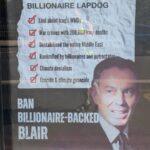Climate finance from multilateral development banks (MDBs) is funding fossil fuels and highly polluting projects, and failing to prioritise the most climate-vulnerable countries. This is according to new research by international organisation Recourse published at the UN climate summit COP29, over climate finance.
COP29 climate finance: all is not what it seems
As MDBs gear up to play a leading role in delivering the new COP29 climate finance goal due to be agreed, this report takes a closer look at the banks’ self-proclaimed “record” figure of $125 billion climate finance in 2023, specifically where the money flowed per region and what type of projects it supported.
The analysis shows that countries in Europe received the largest share, at almost half (44%). Asia-Pacific only received less than half of this amount (21%) followed by Sub-Saharan Africa (no more than 14%).
Finance went to problematic projects, including greenhouse gas-emitting and highly polluting waste-to-energy plants, large-scale hydropower, mining for critical minerals, hydrogen, and ‘captive coal’ for industry – mainly in the form of loans (70%), not grants (4%), adding to the burden of already debt-distressed countries.
Petra Kjell Wright, report author and Campaigns Manager at Recourse, said:
The development banks’ climate finance figures should be read with great caution. We found financing for projects involving fossil fuels, human rights violations, and environmental destruction. This raises serious questions about whether the MDBs’ current approach is genuinely helping to address climate change for the most vulnerable people and places.
The are numerous examples of where MDBs climate finance is, at best, being squandered – and at worst actively harming communities and failing to achieve its goals.
Actively harming the planet and communities
Greater Malé Waste-to-Energy Project in the Maldives is classed as 94-100% climate finance by the Asian Development Bank (ADB) and the Asian Infrastructure Investment Bank (AIIB). In addition to pumping out hazardous fumes and greenhouse gases, the project has caused a net increase of waste as the parliament had to legalise waste importation to feed the plant.
Antalya Airport Expansion Project in Turkey will double capacity from 40 to 80 million passengers, thus significantly increasing the airport’s carbon emissions. The project received $153m from the AIIB in 2023, classed as 48% climate finance.
Upper Trishuli-1 Hydropower Project, the third largest of its kind in Nepal, has severely marginalised and displaced local Indigenous peoples, with the worst economic impacts on women, and failed to follow required consultation processes. Financial investment was counted as climate finance by the World Bank, the AIIB and the ADB – all of which claim to seek to boost economic opportunities for women.
But this is not all that COP29 climate finance initiatives are funding.
Water pollution and land grabbing
Unique Meghnaghat Gas Power Plant in Bangladesh, set to run for at least 22 years, was counted in part as climate finance by the AIIB despite the long-term carbon lock-in that it represents for one of the world’s most climate-vulnerable countries.
The ‘Climate Smart Mining for a New Climate Economy’ project in Mongolia has been flagged as highly risky by over 60 civil society organisations, for potential health impacts, local economic losses, water pollution, land grabbing and Indigenous rights violations. The ADB counted its $500,000 investment as 100% climate finance, in line with the MDBs’ method which counts any mining of transition minerals even if it causes grave harms – contrary to the UN call for a “human rights-based approach to climate finance”.
The report builds on existing evidence that the MDBs’ climate finance is poorly counted, untransparent, and actually adding to debt distress in many countries.
As the MDBs present their role “in shifting climate finance paradigms” at an event in Baku today, experts have responded with withering analysis.
COP29 climate finance: the height of MDBs greenwashing
Zain Moulvi from Alternative Law Collective (ALC) said:
Claims of climate leadership by the multilateral development banks smack of hypocrisy. They cannot celebrate clean energy investments while continuing to support projects that harm people and nature. The MDBs should pay the damages owed to communities harmed by their past investments, and fund the retirement of their fossil fuel projects.
Priti Darooka from BRICS Feminist Watch added:
Climate action isn’t only about reducing emissions and preparing for disasters, it is about tackling inequality and injustice, especially for women in regions worst hit by climate impacts. If the development banks are serious about boosting economic opportunities for women and addressing gender gaps, they should involve women and girls at every stage.
Sukhgerel Dugersuren from Oyu Tolgoi Watch said:
The ADB is using 100% climate finance for what it calls ‘climate smart’ mining in Mongolia which threatens our way of life and our precious nature. But the UN has said that transition minerals supply must put human rights and environmental integrity at its centre. The development banks must not greenwash our destruction.
Petra Kjell Wright concluded of COP29 climate finance via MDBs:
At COP29, the development banks are celebrating their role in climate finance, but our research tells a different story: one of fudged figures, debt distress and finance flowing to the wrong kinds of projects in the wrong places. The banks must put people’s rights and the planet at the heart of their climate finance to truly live up to their commitment to align with the Paris Agreement.
Featured image via the Canary





















